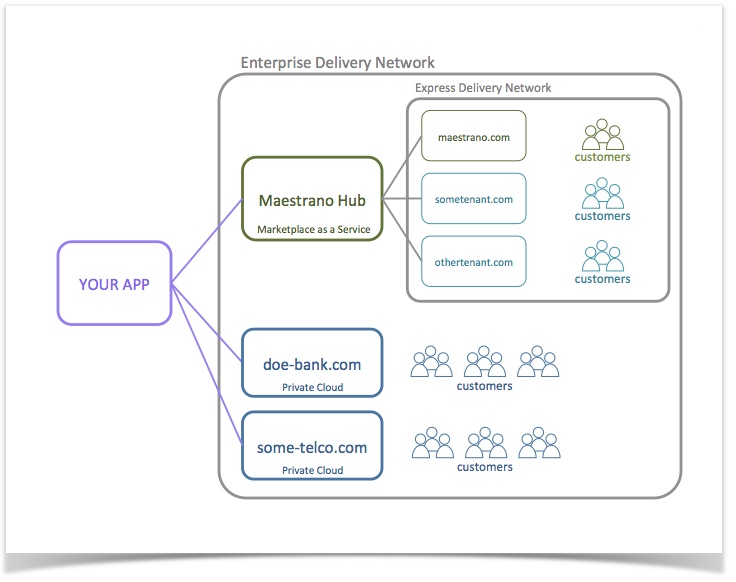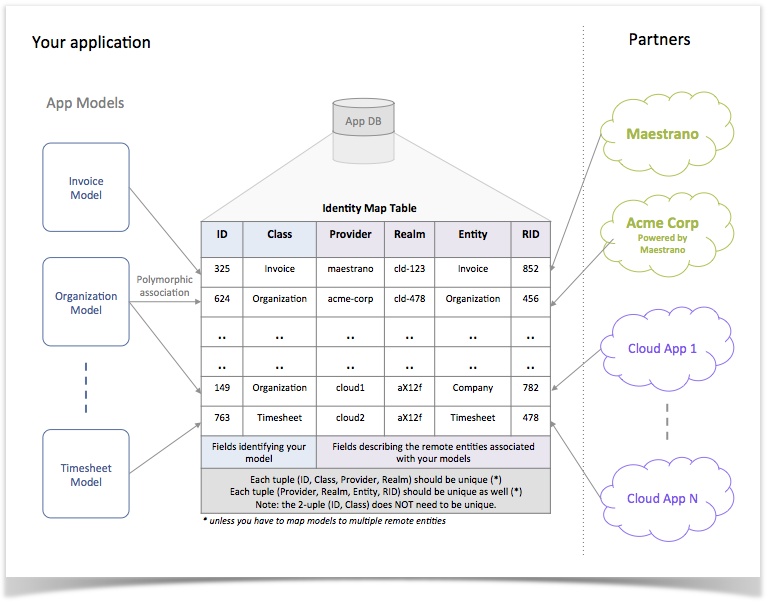Deprecated section
This section of our wiki is deprecated. You landed here because we developed new better tools to integrate with Maestrano and our Partners. We now have a brand new Developer Platform which simplifies a lot your integration on all our Partner Marketplaces (both to manage marketing listing and to manage your technical integration).
If your application is already integrated with Maestrano, do not panic! Your integration still works perfectly. To simplify your journey with us and our partner's marketplaces, we will onboard you soon on the developer platform. If you want to know more, just send us an email (developers@maestrano.com), nothing to be afraid of ![]()
1 Summary
The goal of this paper is to provide tips and good practices on how to perform a multi-tenant integration with Maestrano, i.e be able to handle multiple Maestrano-powered marketplaces including Maestrano.com.
The Maestrano delivery network is essentially composed of two types of marketplaces:
- Enterprise Network: these enterprise tenants run the Maestrano infrastructure in their private cloud. In order to publish your application to these tenant marketplaces you will need to 1) have an agreement with them (which we can facilitate) and 2) add a configuration manifest to your application allowing you to "discover" their API endpoints.
- Express Network: these tenants run their own marketplace using the Marketplace as a Service (MaaS) offering powered by Maestrano's cloud. Being an app provider on maestrano.com makes you automatically available on these marketplaces - meaning you do not need to do anything on your side. Please note that the marketplace owners may choose to restrict their offering to a limited number of apps.
The diagram below provides a general overview of the Maestrano Enterprise Delivery Network:
2 Principles
When doing multi-tenant integrations, three concepts need to be considered and properly scoped: Configuration, Routes and Models.
Configuration scoping
Your application should be able to fetch the right API configuration (e.g.: which REST API host to use) based on the context of a controller action and/or database model. Multi-tenant configuration is achieved by associating a configuration manifest to a "tenant key" (unique identifier) which will then be used to tag models and to parameterize routes.
Route scoping
One way of understanding the context of incoming traffic is to properly scope urls using the tenant key mentioned above. E.g.: Webhooks coming from Maestrano should hit a url like "/maestrano/some-webhook" while webhooks coming from another tenant should look like "/sometenant/some-webhook". In a more general manner, multi-tenant URLs should be parameterized using a tenant key parameter: "/:tenant_key/some-webhook"
Model scoping
When storing records related to Maestrano and/or Maestrano Enterprise Tenants, your application should be able to keep track of which tenant and which tenant customer account this record is related to. This is usually done by storing a tenant key - and tenant customer account id - on the record or in an identity map table (see section 4).
3 Example of multi-tenant integration (pseudo code)
The example below gives a high level overview of what your code may look like in the context of a multi-tenant integration. If you have already done the integration to maestrano.com the code below will look familiar and essentially intends to show how you can "extend" your current integration to make it multi-tenant.
The code samples show you the general steps involved in getting a basic multi-tenant setup for Single Sign-On, Single Billing and Connec data sharing. Note that for this example, we assume the use of one of Maestrano's SDKs - available in Ruby, Java, PHP and .NET.
3.1 Configuration
The configuration is automatically taken care of by the autoconfigure method.
If your application is environment is set up on more than one marketplaces (or MnoHub), the autoconfigure method will call the https://developer.maestrano.com/api/config/v1/marketplaces endpoint in order to retrieve the different configurations per marketplaces.
# This piece of code should be put in an initializer.
#
Maestrano.autoconfigure({
host: "https://developer.maestrano.com",
api_path: "/api/config/v1",
environment: {
name: "[your environment nid]"
api_key: "[your environment key]"
api_secret: "[your environment secret]"
}
})
# To retrieve the configuration per marketplace you may call
Maestrano.with(marketplace)
# that will contains all the configuration settings for this marketplace
# # Let's create parameterized routes # # The single sign-on routes will be used by enterprise tenants to trigger and complete SSO handshakes route "/mno-enterprise/:marketplace/saml/initialize" to "SamlSsoController" on action "initialize" route "/mno-enterprise/:marketplace/saml/consume" to "SamlSsoController" on action "consume" # The Account Webhook routes notify you of groups being removed or users being removed from groups route "/mno-enterprise/:marketplace/account/group/:id" to "AccountWebhookController" on action "destroy_group" route "/mno-enterprise/:marketplace/account/group/:group_id/user/:id" to "AccountWebhookController" on action "remove_user" # The Connec!™ webhook route will be used by enterprise tenants to POST data sharing notifications route "/mno-enterpise/:marketplace/connec/receive" to "ConnecWebhookController" with action "receive"
3.2 Single Sign-On
OpenID also available!
The example below assumes you are using our SDK for Single Sign-On which is based on SAML 2.0. Maestrano also has an OpenID provider available. Want to know more? Just checkout our OpenID guide.
#
# This controller handles the Single Sign-On handshake
#
class SamlSsoController
# The 'initialize' controller action responds the following route
# GET /mno-enterprise/:marketplace/saml/initialize
#
# The goal of this action is to trigger the Single Sign-On handshake
# between the tenant platform and your application
function initialize
# Retrieve the marketplace from the URL parameters
marketplace = params['tenant_key']
redirect_to MaestranoSamlRequest.with(marketplace).new(params).redirect_url
end
# The 'initialize' controller action responds to the following route
# POST /mno-enterprise/:marketplace/saml/consume
function consume
# Retrieve the tenant key from the URL parameters
marketplace = params['marketplace']
# Process the response
saml_response = Maestrano::Saml::Response.with(marketplace).new(params[:SAMLResponse])
# Reject if invalid
unless saml_response.is_valid?
redirect_to "/some/error/path"
end
# Extract information from the response
user_attributes = Maestrano::SSO::BaseUser.new(marketplace, saml_response).to_hash_or_associative_array
group_attributes = Maestrano::SSO::BaseGroup.new(marketplace, saml_response).to_hash_or_associative_array
# Find/create the user and the organization
# The creation or retrieval of records should be scoped to a specific provider (marketplace)
user = User.find_or_create_for_maestrano_tenant(user_attributes, marketplace)
organization = Organization.find_or_create_for_maestrano_tenant(group_attributes, marketplace)
# Add user to the organization if not there already
unless organization.has_member?(user)
organization.add_member(user)
end
# Sign the user in and redirect to application root
# To be customised depending on how you handle user
# sign in and
sign_user_in(user)
redirect_to "/some/post-login/path"
end
end
3.3 Account Webhooks
#
# This controller handles notification of people leaving a group (remove_user action) or companies
# cancelling their subscription to your service (destroy_group)
class WebhookAccountController
# The 'destroy_group' controller action responds the following route
# DESTROY /mno-enterprise/:marketplace/account/group/:id
function destroy_group
# Retrieve the request parameters
marketplace = params[:marketplace]
group_uid = params[:id]
# Authenticate request as usual
unless Maestrano.with(marketplace).authenticate(http_basic['login'],http_basic['password'])
return render json: "Unauthorized, code: '401'
end
# Retrieve the group/company
organization = Organization.find_by(marketplace: marketplace, uid: group_uid)
# Destroy it
organization.destroy
end
# The 'destroy_group' controller action responds the following route
# DESTROY /mno-enterprise/:marketplace/account/group/:group_id/user/:id
function remove_user
# Retrieve the request parameters
marketplace = params[:marketplace]
group_uid = params[:group_id]
user_uid = params[:id]
# Authenticate request as usual
unless Maestrano.with(marketplace).authenticate(http_basic['login'],http_basic['password'])
return render json: "Unauthorized, code: '401'
end
# Retrieve the group/company as well as the user
organization = Organization.find_by(marketplace: marketplace, uid: group_uid)
user = User.find_by(marketplace: marketplace, uid: user_uid)
# Remove the user
organization.remove_user(user)
end
end
3.4 Billing
The code below shows how to bill an organization which has been tagged with a marketplace key. All Maestrano SDKs offer the ability to scope REST calls with a marketplace key. See the documentation of the relevant SDK for more details.
class MonthlyBillingJob
# Run the billing job
function run
foreach organization in Organization.all()
if organization.maestrano_marketplace != null
# Use Maestrano's billing API
Bill.with(organization.maestrano_marketplace).create(amount: $100, group_id: organization.maestrano_uid)
else
# For your own customers, just charge as usual
organization.charge_credit_card($100)
end
end
end
end
3.5 Connec Data Sharing
The code sample below shows an example of model automatically forwarding a notification to Connec! upon save, in a multi-tenant way.
class InvoiceModel
function save
return false unless this.save_to_db
if this.maestrano_uid
client = MaestranoConnecClient.with(this.maestrano_marketplace).new(this.maestrano_group_uid)
client.post('/invoices', this.to_maestrano_json)
end
end
end
3.6 Connec Webhooks
# This controller processes any data sharing notifications sent by marketplaces via
# Connec!
# E.g.: I receive a new invoice from Connec!™ that was created in another application
class WebhookConnecController
# The 'receive' controller action responds to the following route
# POST /mno-enterprise/acme-corp/connec/receive
function receive
# Retrieve the tenant key from the URL parameters
marketplace = params['marketplace']
# Authenticate request as usual
unless Maestrano.with(marketplace).authenticate(http_basic['login'],http_basic['password'])
render json: "Unauthorized, code: '401'
end
# Finally, process the request for a specific marketplace
MyConnecWrapperClass.process_invoice_updates(params['invoices'], marketplace)
end
end
4 Good practice: handling objects connected to third parties
You may have - or anticipate to have - a couple of integrations with platforms like Maestrano, QuickBooks, Xero, SalesForce etc. which will require you to synchronize objects using their APIs. For each of these objects, you will need to keep track of the foreign ids associated with the objects you've remotely created and/or received ("connected objects").
Question is: how to properly handle the linking of remote objects to your application models?
Maestrano's approach and recommended way of doing this is to use an identity map table (or "id map"). An id map is a join table allowing you to link any kind of model on your side to remote entities on the other side.
The id map identifies models/records in your application using the following fields:
- ID: the id of the record in your model table (e.g.: invoices table)
- Class Name: the name of the class for your model (e.g.: Invoice)
On the other side, remote entities are identified using the following fields:
- Provider: the key identifying the provider for the remote entity (e.g.: Maestrano, Acme Corp, Xero, QuickBooks etc.). For Maestrano Enterprise tenants, this is the tenant key.
- Realm: the ID of the customer account (organization/company or user) who owns the remote entity. For Maestrano and Maestrano Enterprise tenants, this is the group id.
- Entity: the name of the remote entity. You should be able to derive the path of the entity API endpoint from this name.
- RID: the ID of the remote entity.
The diagram below summarizes the concept:
The ID map makes it easy to write reusable code for connected objects. The pseudo code below shows how one could right a module, composing trait, interface or abstract class handling all the logic.
#
# This class define the actual model mapped to the identity map table
#
@table='id_map'
class IdMapModel inherits MyFavoriteOrmBaseClass
integer id
string class_name
string provider
string realm
string entity
string rid
# Return the resource URL of the remote entity
function remote_url
manager = MyApiConfigManager.get_config(this.provider)
api_host = manager.api_host
api_path = manager.api_root_path
return host + api_path + "/" + this.entity.downcase + "/" + this.rid
end
end
module ConnectedObjectModule
function id_maps
IdMapModel.where(id: this.id, class_name: this.class.to_string)
end
function id_map_for(provider,realm)
IdMapModel.where(id: this.id, class_name: this.class.to_string, provider: provider, realm: realm).first
end
end
#
# Add connected object behaviour to an existing model
#
class MyInvoiceModel inherits MyFavoriteOrmBaseClass extend_module ConnectedObjectModule
end
# Retrieve a model
inv = MyInvoiceModel.find(123)
# Get the URL of a linked resource
inv.id_map_for("maestrano","a-group-id").resource_url
Do as you see fit
The example above shows one way of handling connected objects and does not pretend to be a silver bullet. Your application may have different integration requirements. Do not hesitate to change, extend or simply adopt other patterns based on what you need to do!

